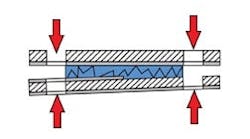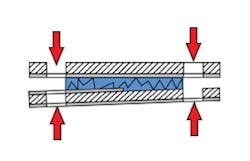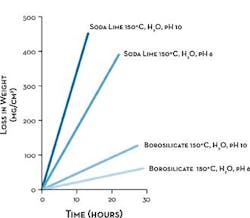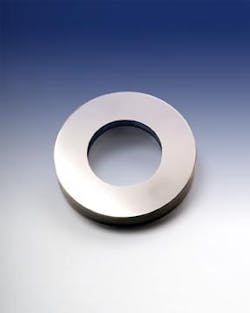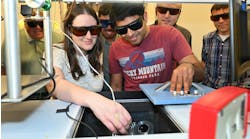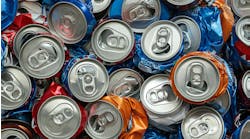Forestall Sight Glass Failure
Despite the advances in measuring flow and level electronically, a need for visual confirmation often exists in chemical processing. There is no simpler and more-reliable means to verify measurements, witness process steps or observe fluid characteristics than with a sight glass. That’s why many process vessels are ordered with sight glasses and others are retrofitted with them. However, the potential failure of sight glass windows is a real concern. In many chemical processing applications, poorly specified or installed sight glasses may pose the greatest risk of leaks and accidents in the system.
Properly specified and installed sight glasses can be incredibly pressure-, temperature- and corrosion resistant. However, when glass fails, it often fails suddenly and catastrophically. Glass can crack at five miles per second, ejecting shards at speeds approaching Mach 25. Investigators of a failure at a nuclear power plant found glass embedded in a steel railing six feet away. In three incidents, sight glass failures cost more than $67 million in damages, $1.5 million in downtime and multiple lives. Proper sight glass selection, installation and maintenance are critical to avoiding these risks.
Figure 1. Improper bolt tightening and gasket residue can transfer a bending load into the glass.
Common Culprits
Seven factors contribute to sight glass failures:
1. Improper design. Sight glasses are highly engineered assemblies of flanges, bolts, gaskets and glass. Each component in the assembly is critical to its performance. The type of metal, the kind of glass and the gasket material all must meet design criteria. A flange that is too thin may bend during bolt tightening, transferring a bending load into the glass. Even flanges of proper thickness can cause cracks if they have too few bolts, by creating point loads from uneven glass compression. Improper design of the sight glass for the application can be the first step toward a failure.
2. Faulty installation. Over-tightening or uneven torqueing of bolts can generate bending loads on the glass (Figure 1). When replacing glass, trapped debris (often residue from baked-on gaskets) can cause point loads or scratch glass during installation. Any scratches to the glass or damage to gaskets prior to installation can lead to leakage or failure.
3. Mishandling during operation. Maintenance personnel may use a sight glass as a convenient place to rest a wrench. A tiny impact or scratch, even from a gloved hand, can weaken the glass. Just tapping the glass or using harsh cleaning agents can damage the glass. Once installed, the less contact with the glass, the better.
[javascriptSnippet ]
4. Glass disc re-use. According to a technical glass handbook published by Corning Inc., glass removed from service should not be reused. Stressing and then destressing the glass can cause tiny faults. Visual inspection won’t always detect these tiny cracks, so it’s best to replace glass removed from an assembly. The exception is the type of sight glass that is fused to a steel frame; here, the frame takes all the stress of installation.
5. Thermal shock. This may occur during a system startup in which temperature rises rapidly. If the inner surface of the glass expands faster than the outer, the glass can crack. Alternatively, during external washdown, cold water on a hot sight glass can cause the outer surface to contract faster than the inner. Borosilicate glass (e.g., Pyrex) resists damage from thermal stress better than common soda lime glass. It also can handle higher service temperatures: tempered borosilicate glass is rated to 280°C (536°F) compared to the 150°C (302°F) rating of tempered soda lime glass.
6. Over-pressurization. Even though safety devices will relieve a dangerous pressure rise, they may not act fast enough to prevent damage to the glass. Sight glasses are designed with a safety factor but design pressures never should be exceeded during normal operation.
7. Degradation. Glass can suffer erosion over time from contact with coarse process media. In addition, glass itself can react with process fluid, so chemical erosion also is common. Degradation, theoretically, may weaken the glass to the point of catastrophic failure. However, the gradual degradation more likely will lead to a slow-motion failure, which is the loss of visibility. Sight glasses can acquire a cloudy appearance, especially if the process media is caustic, necessitating frequent sight glass replacement. Specifiers should consider the better resistance to chemical and physical erosion of borosilicate glass compared to soda lime glass (Figure 2).
Figure 2. Borosilicate glass loses far less weight over time than soda lime glass.
Safety Sight Windows
For years, attempts have been made to construct safe sight glasses using dual windows, laminated glass, wire mesh, etc. However, these approaches don’t fully address the true causes of failure, which are the characteristics of the glass itself.
Glass is sensitive to tensile stress. Think of a glass cutter: a shallow scratch causes a weak point, called a stress riser, and the addition of a bending moment allows the glass to be easily snapped. Conversely, glass is amazingly strong in compression. It is similar to concrete in this way: strong under compressive stress, vulnerable under tensile stress.
Fused sight glasses combine a metal outer ring with a glass inner core (Figure 3). This combination of materials, when properly executed, creates a super strong sight window for extreme applications. During manufacture, glass is melted inside a metal ring and fuses to the metal. Because the glass and metal have different coefficients of thermal expansion, the glass hardens before the metal ring shrinks back to its original size. This places the ring in tension and the glass in uniform radial compression.
The homogeneous compression offsets the effects of tensile stress. This constant compressive force on the glass greatly increases the sight glass’ resistance to high pressure and physical and thermal shock. In effect, the glass becomes elastic, which is the surprising ability to bend without breaking. Taken to an extreme, the outside glass may crack but the subsurface glass, which still is under compressive force, will retain its integrity.
Figure 3. This design fuses glass to a metal frame and maximizes compression of the glass.
The design challenge is to combine metal and glass types to maximize the compression on the glass without exceeding a point where the glass will shatter. Sight glass manufacturers have tried various kinds of glass and different steel alloys. In practice, they only use soda lime glass and borosilicate glass because these provide the optimal coefficients of thermal expansion. Manufacturers employ a variety of metals, including duplex stainless steels, high nickel alloys and carbon steel. Type-316 stainless steel isn’t recommended because its coefficient of thermal expansion is too high and will crack the glass. The difference in the thermal coefficients of expansion of the materials used enables prediction of the amount of compression.
Borosilicate glass has a lower coefficient of expansion than soda lime glass and, thus, causes higher levels of compression inside the metal ring. A paper by Karl Schuller of Herberts Industrieglas GmbH concluded that fusing borosilicate glass creates 2.8 times more compression than fusing soda lime glass. This higher compression increases the maximum operating pressure of a fused borosilicate sight glass 4.5 times. Therefore, fused borosilicate sight glasses are much stronger than fused sight glasses made with ordinary soda lime glass (Figure 4).
Figure 4. Sight glass made of duplex stainless steel and borosilicate glass outperforms one made of a high-nickel alloy (Hastelloy C-22) and soda lime glass. (Soda lime glass is not rated for use above 302°F.)
Strength translates into more-reliable, safer operation. For example, fused borosilicate sight glasses are part of sampling and testing equipment used for oil analysis aboard U.S. Navy vessels. Because reliability is critical, the sight glasses, specified to operate at continuous 2,600 psi, were put through destructive testing. The Navy tried to test the sight glass to the point of failure but the test apparatus failed before the sight glass did.
A common misunderstanding is that reliability is a result of fusion between the glass and metal. Fusion is easy to achieve, a byproduct of manufacturing. It is compression, rather than fusion, that gives sight glass windows their strength.
Fused sight windows are a safe choice for high-temperature and high-pressure applications. For other applications, glass discs may suffice, provided the seven causes of sight glass failure are addressed during installation, maintenance and operation.
Non-Catastrophic Failures
Safety issues posed by catastrophic failure shouldn’t be the only concerns chemical plant managers have about sight glasses. Non-catastrophic failures can lead to leaks, spills and contamination that may result in costly downtime (which totals more than $700,000/hr for a petrochemical plant, estimates the META Group). Fortunately, the same physics that make metal-framed fused sight glass windows safe also make them highly reliable. Maintenance costs are further reduced because fused sight glass windows may be returned to service after removal, rather than needing to be replaced. However, fused sight glasses usually offer smaller view diameters than standard sight glasses. This underscores that there are cost and performance tradeoffs between glass and fused glass. Specifiers should consider the particular needs of each application when selecting the best design and materials for each project.
ERIC VAN STEENLANDT is chief operating officer of L.J. Star, Inc., Twinsburg, Ohio. E-mail him at [email protected].
